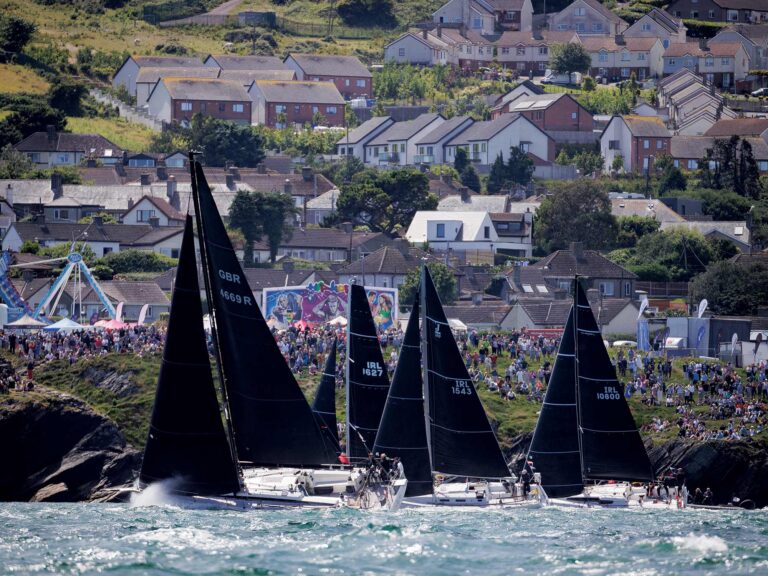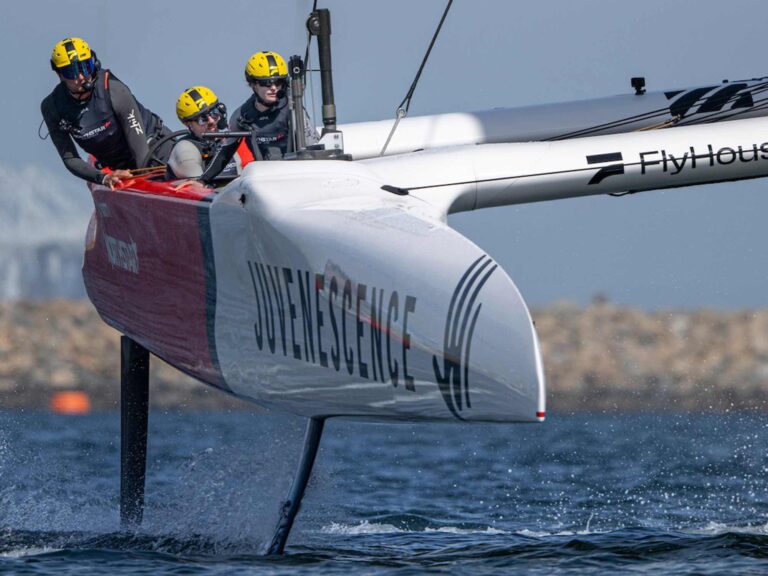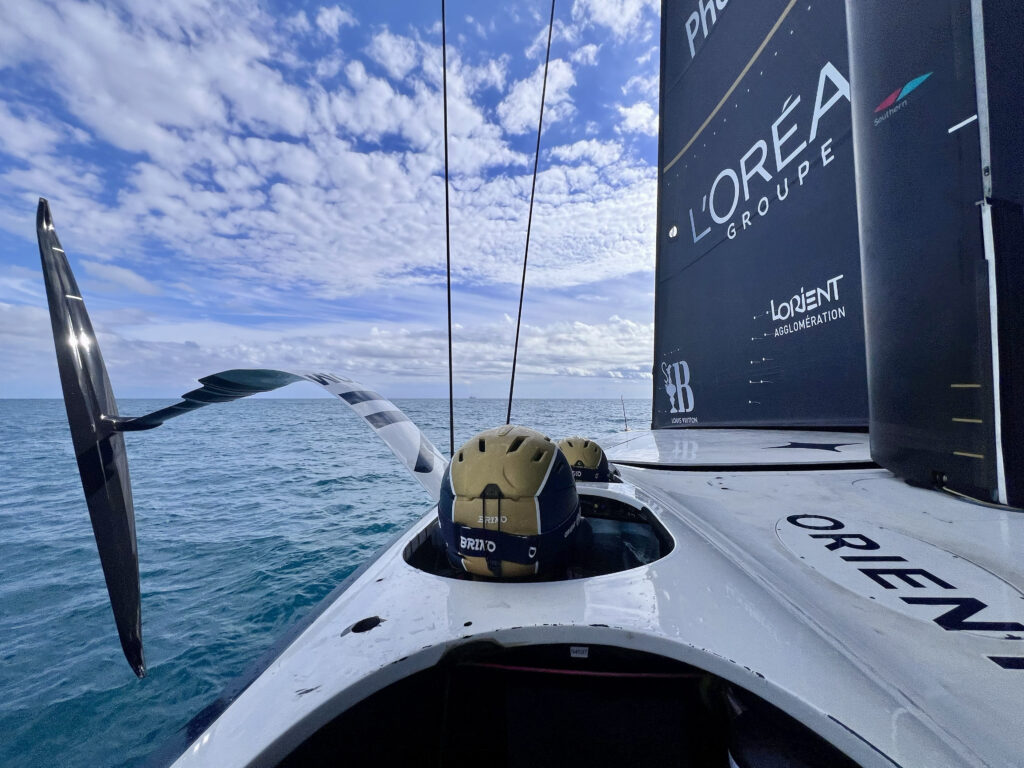
On the eve of the Louis Vuitton 37th America’s Cup Match, the America’s Cup Media Center on the ground floor of Barcelona’s World Trade Center is relatively empty. Both challenger and defender alike are hunkered down and most of the accredited media are off exploring cultural gems of the city or taking a breather before the Cup rush.
The only action is the Puig Women’s America’s Cup qualifying races, and while I sit awaiting the delayed start I get a text message from Sabina Mollart-Rogerson, the international media liaison for the French Orient Express Racing Team. They’re taking guests sailing on its AC75 and there are two spots for journalists. Do I want to go?
She does not need to ask twice. “Must be present to win,” I mutter to myself.
With my laptop briskly shoved into my backpack, I hustle to meet Mollart-Rogerson waiting in a team courtesy car, hastily board a RIB at the base and then transfer to a chase boat sitting along the AC75. Alexander Smith, of Reuters, is getting his safety briefing from the team’s paramedic—a quick tutorial on how to use the PFD’s spare air system and the hand signals should the boat capsize and we end up in the drink.
Smith is first to get into this rare AC75 joyride and as we follow alongside I meet Enzo Balanger, the mustached young Frenchman who skippered the team’s AC40 in the UniCredit Youth America’s Cup. Today will be his first time onboard the AC75 and his first shot at driving the big beast of a foiler. He’s had a few runs in the simulator, but he tells me he’s eager for the real thing as he observes the boat intently from his seat inside the RIB.
After 20 minutes or so, the boat comes to a slow stop and parks head-to-wind. Smith gingerly steps off the foredeck and onto the RIB with the expected ear-to-ear grin. I take his helmet, slide it on, adjust it and clip the chin strap. It’s a heavy, bobble-head like feel. With my PFD zipped and snugged, I move to the front of the RIB and before I board I’m warned several times about the slipperiness of the foredeck, and not to step on the deck area above the jib track–it will break.
With bare feet on the polished white deck it is indeed slippery, but I find awkward footing on the non-skid decals and crawl crab-like toward the mast and into the port-side opening behind the helmsman’s cockpit. The cycling apparatus that once served to power the boat through the Louis Vuitton Cup races has been removed. What remains is a bike saddle on a post, foot pads and forearm handlebars with grip tape worn thin and shredded by cyclors giving their all. A puddle of water sloshes around in the bilge and in front of me is a small LCD screen and a laminated list with checkboxes and instructions in French that I cannot decipher. I can only assume it’s the cyclor’s pre-flight check list.
To be honest, I was hoping to push some pedals to see how hard it could really be, but I’m OK with the cruise.
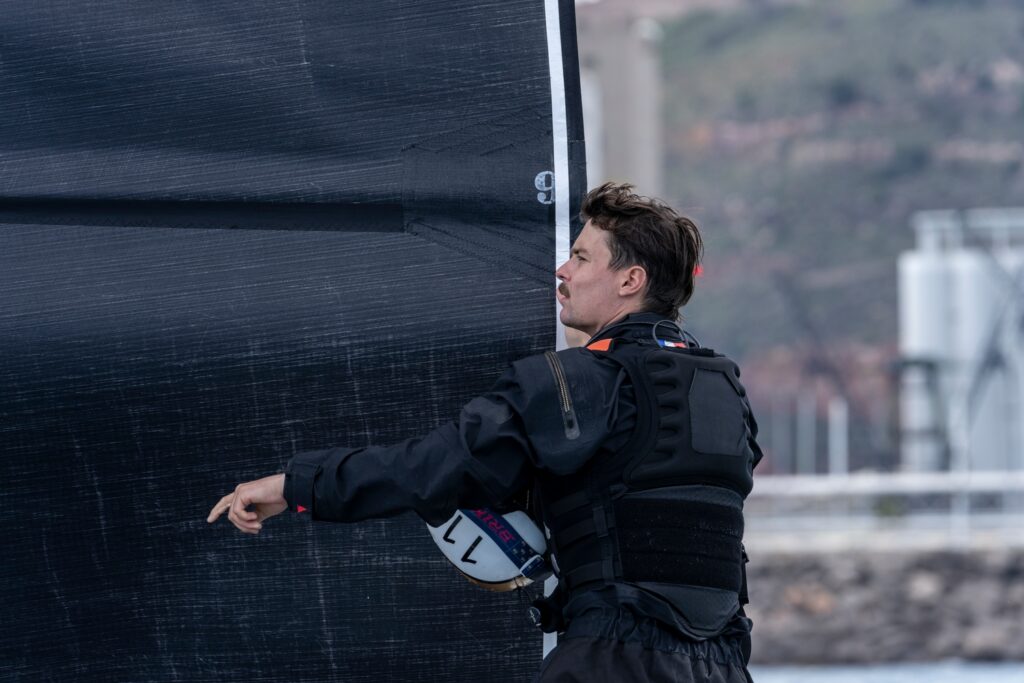
Behind me is one of the team’s cyclors, and helming in the opposite side of the boat is starting helmsman Quentin Delapierre. Balanger slides into the cockpit in front of me and scans the many displays in front of him, presumably doing his pre-flight checks and orientating himself. He slides his goggles down over his eyes and adjusts his facemask as the boat bears away and starts sailing on port tack.
All I can hear over the headset built into my helmet is the chatter among the cyclors. I’m on a closed loop between them, and even if I could listen to Delapierre coaxing Balanger, I would have no idea what was being said. I don’t do French, so I’m well and truly along the ride.
As the boat slowly accelerates, both foils in the water, a rush of wind across the deck is immediate. Hydraulic pumps inside the boat groan and I can hear and feel the whir of the cyclors pushing oil throughout the boat. The jib clew slides out to the outboard end of the recessed foredeck track, the tack rises and the foot deepens and rounds.
A small green box on the LCD display in front of me reads 12.3 knots as the boat heels briefly to weather and then comes level as the boat lifts free of the surface. The jib clew quickly comes inboard, the leech hardens, and what was once a deep-cambered sail is now board flat. I peek over the rail and stare with wonder at the foil wing gliding just below the surface, its pointed upward-curved outer tip zippering the water.
From my vantage point, I can easily see approaching puffs through the jib slot, and find myself counting them down in my head and watching how the boat and the sails react. The jib car is constantly moving inboard and outboard, inches a time. Behind me, the traveler is hyperactive.
In a blink we’re doing 28 knots in 9 knots of wind before Delapierre drops the windward foil and starts the turn through our first foiling tack. I watch Balanger scan his displays through the turn before looking forward over the bow and at the straight horizon. I can see video screens showing camera views of both foils, but there are other displays in front of him with a jumble of numbers.
Once settled on the new tack the windward foil rises free of the water and the speed loss through the tack is barely noticeable. With Balanger now on the helm the boat lumbers and bounces like a large prop-plane through turbulence. At full tilt, there’s just wind noise through my helmet, the hum turning cranks and pumps pushing oil. Telltales along the bottom of the jib and mainsail stream straight back as if glued to the sails.
Balanger seems plenty smooth on his first long port run, the windward board’s tip only dipping occasionally. The display in my cockpit is blinking with colors, numbers I don’t understand, power data from cyclors, and percentages for the jib sheet and the mainsail traveler as the true-wind angle bounces between 40 and 50-something degrees.
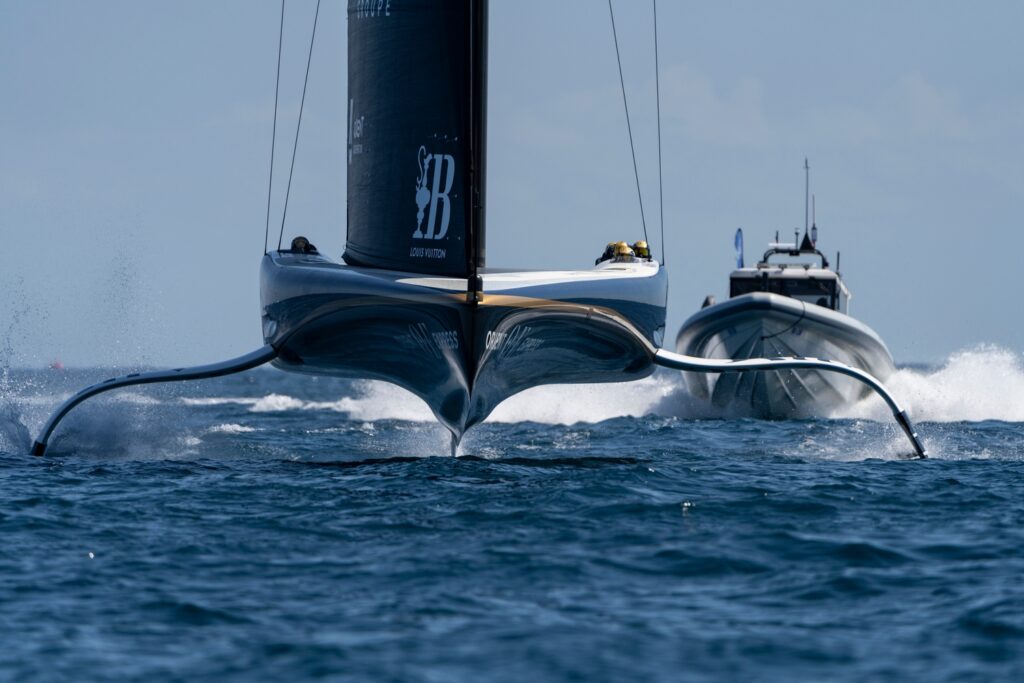
After a few minutes of straight-line sailing at 29 knots it all starts to feel pretty relaxed, and it’s only when we bear away to somewhere past 100 degrees true that the rush of the AC75 becomes real. Suddenly, it’s 37 knots, a cheeks-flapping, head-swaying sort of pace, a sense of floating on air.
We glide through a few more jibes and speed runs before turning into the wind and coming to a slow stop. The ride is over and with it, the same sort of let down that comes after an epic roller coaster ride. That feeling that you want to jump right back into the cue, no matter how long it is, for another go. According to my Garmin watch we’ve covered 6.87 miles in 20m:38s, at an average speed of 20 knots. Somehow, I’ve burned 127 calories just sitting on my saddle, a mere fraction of the cyclors who were doing all the heavy cranking.
Mine is the last ride of the day and after a fast and short tow back to the base, I get 5 minutes of one-on-one with Balanger before he’s whisked off to the debrief. While it seems to me his turns were just fine for an AC75 first-timer—no splashdowns or touches—he confesses that it was far from good, but it’s all part of getting up to speed and hopefully into a starting role when the French challenger returns to the next Cup.
“During my first tack, the traveler was a bit stuck in the middle,” he says with a chuckle. “I tried to turn the wheel but the boat didn’t turn.”
He was out of sync with the trimmers, but the next one was better: “When I didn’t get my first tack well, I just watched how Quentin did the next one, and then I just did the same. There is a lot of precision and coordination, and it is not easy.”
Recalling this first few minutes on the helm of the AC75 Balanger says that while it would have been tempting to focus on the array of displays in front of him, he instead drew upon his instincts gleaned from his high-level Moth sailing.
“I wasn’t too focused on the data,” he says, “just the heel and the feel of the boat and the wind. Of course, I was nervous but everyone was supporting me, the cyclors telling me to push a bit more, saying, ‘we have some power for you.’”
Although I could not hear Delapierre mentoring from the opposite cockpit, Balanger says, he wasn’t telling him whether he was doing well or not. “He was just telling me that it was my first time and that everyone wants to perform. He was giving me a lot of advice and told me it was good—but only at the end.”







